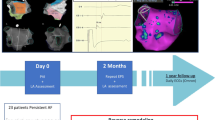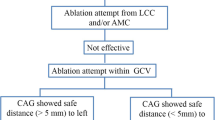Abstract
Purpose
Left ventricular (LV) electrical activation pattern could determine optimal LV lead placement site during cardiac resynchronization therapy (CRT) device implant. We sought to determine the feasibility of using EnSite NavX™ electroanatomic mapping system (St. Jude Medical Inc., St. Paul, MN) to assess LV electrical activation during CRT implant.
Methods
Patients (n = 32; NYHA III, LVEF <35 %, QRSd >120 ms) underwent NavX™ mapping during CRT implant. Left bundle branch block (LBBB) was present during sinus rhythm in group A (n = 17), whereas LBBB was induced by permanent RV apical pacing in group B (n = 15). Following coronary sinus (CS) cannulation, a coil tip 0.014-in. guidewire was introduced into all available CS branches as a mapping electrode. Each patient’s unipolar activation map was successfully constructed within 10 min, using the onset of surface QRS as reference.
Results
LV activation patterns were complex and varied in both groups. Earliest activation was usually apical, but latest activation was more heterogenous. The lateral or posterolateral branches were the sites of latest activation in 47 % of group A and 73 % of group B. An LV lead positioned conventionally by a physician blinded to the mapping data was concordant with the latest activated segment in 18 % of group A and none of group B patients.
Conclusions
Electroanatomic mapping of the CS tributaries is feasible and clinically practicable. Mapping revealed heterogenous conduction patterns that vary between patients in each group and between groups. An LV lead empirically placed in a lateral branch rarely paces the optimal, latest activated vein segment.



Similar content being viewed by others
References
Cleland, J. G., Daubert, J. C., Erdmann, E., Freemantle, N., Gras, D., Kappenberger, L., Cardiac Resynchronization-Heart Failure (CARE-HF) Study Investigators, et al. (2005). The effect of cardiac resynchronization on morbidity and mortality in heart failure. New England Journal of Medicine, 352(14), 1539–1549.
Reant, P., Zaroui, A., Donal, E., Mignot, A., Bordachar, P., Deplagne, A., et al. (2010). Identification and characterization of super-responders after cardiac resynchronization therapy. American Journal of Cardiology, 105(9), 1327–1335.
Rickard, J., Kumbhani, D. J., Popovic, Z., Verhaert, D., Manne, M., Sraow, D., Baranowski, B., et al. (2010). Characterization of super-response to cardiac resynchronization therapy. Heart Rhythm, 7(7), 885–889.
Singh, J. P., Klein, H. U., Huang, D. T., Reek, S., Kuniss, M., Quesada, A., et al. (2011). Left ventricular lead position and clinical outcome in the multicenter automatic defibrillator implantation trial-cardiac resynchronization therapy (MADIT-CRT) trial. Circulation, 123(11), 1159–1166.
Wilton, S. B., Shibata, M. A., Sondergaard, R., Cowan, K., Semeniuk, L., & Exner, D. V. (2008). Relationship between left ventricular lead position using a simple radiographic classification scheme and long-term outcome with resynchronization therapy. Journal of Interventional Cardiac Electrophysiology, 23(3), 219–227.
Varma, N. (2008). Left ventricular conduction delays induced by right ventricular apical pacing: effect of left ventricular dysfunction and bundle branch block. Journal of Cardiovascular Electrophysiology, 19(2), 114–122.
Auricchio, A., Fantoni, C., Regoli, F., Carbucicchio, C., Goette, A., Geller, C., et al. (2004). Characterization of left ventricular activation in patients with heart failure and left bundle-branch block. Circulation, 109(9), 1133–1139.
Singh, J. P., Fan, D., Heist, E. K., Alabiad, C. R., Taub, C., Reddy, V., et al. (2006). Left ventricular lead electrical delay predicts response to cardiac resynchronization therapy. Heart Rhythm, 3(11), 1285–1292.
Jia, P., Ramanathan, C., Ghanem, R. N., Ryu, K., Varma, N., & Rudy, Y. (2006). Electrocardiographic imaging of cardiac resynchronization therapy in heart failure: observation of variable electrophysiologic responses. Heart Rhythm, 3(3), 296–310.
Merchant, F. M., Heist, E. K., McCarty, D., Kumar, P., Das, S., Blendea, D., et al. (2010). Impact of segmental left ventricle lead position on cardiac resynchronization therapy outcomes. Heart Rhythm, 7(5), 639–644.
Lambiase, P. D., Rinaldi, A., Hauck, J., Mobb, M., Elliott, D., Mohammad, S., et al. (2004). Non-contact left ventricular endocardial mapping in cardiac resynchronisation therapy. Heart, 90(1), 44–51.
Gold, M. R., Birgersdotter-Green, U., Singh, J. P., Ellenbogen, K. A., Yu, Y., Meyer, T. E., et al. (2011). The relationship between ventricular electrical delay and left ventricular remodelling with cardiac resynchronization therapy. European Heart Journal, 32(20), 2516–2524.
Szilagyi, S., Merkely, B., Roka, A., Zima, E., Fulop, G., Kutyifa, V., et al. (2007). Stabilization of the coronary sinus electrode position with coronary stent implantation to prevent and treat dislocation. Journal of Cardiovascular Electrophysiology, 18(3), 303–307.
Demir, A. D., Cay, S., Erbay, A. R., Maden, O., Atak, R., & Balbay, Y. (2010). Long-term follow-up data of coronary sinus stenting for the stabilization of the left ventricular leads. Pacing and Clinical Electrophysiology, 33(12), 1485–1489.
Ypenburg, C., van Bommel, R. J., Delgado, V., Mollema, S. A., Bleeker, G. B., Boersma, E., et al. (2008). Optimal left ventricular lead position predicts reverse remodeling and survival after cardiac resynchronization therapy. Journal of the American College of Cardiology, 52(17), 1402–1409.
Fung, J. W., Lam, Y. Y., Zhang, Q., Yip, G. W., Chan, W. W., Chan, G. C., et al. (2009). Effect of left ventricular lead concordance to the delayed contraction segment on echocardiographic and clinical outcomes after cardiac resynchronization therapy. Journal of Cardiovascular Electrophysiology, 20(5), 530–535.
Butter, C., Auricchio, A., Stellbrink, C., Fleck, E., Ding, J., Yu, Y., Pacing Therapy for Chronic Heart Failure II Study Group, et al. (2001). Effect of resynchronization therapy stimulation site on the systolic function of heart failure patients. Circulation, 104(25), 3026–3029.
Acknowledgments
The authors gratefully acknowledge Joe Grundle, Katie Klein, and Susan Nord of Aurora Cardiovascular Services for the editorial preparation of the manuscript and Brian Miller and Brian Schurrer of Aurora Sinai Medical Center for their help in preparing illustrations.
Conflict of interest
Dr. Niazi receives study grants and consulting fees for product development from and has stock in Medtronic Inc.; he receives consulting fees for product development from Osprey Medical Inc. and St. Jude Medical Inc.; he participates in research grants from Biotronik Inc., Boston Scientific Corp., Sanofi-Aventis, Janssen Pharmaceuticals, and Bristol-Myer Squibb Co.; and he participates in speaker bureaus for Sanofi-Aventis and Janssen Pharmaceuticals. Dr. Ryu and Mr. Hood are employed by St. Jude Medical. Dr. Choudhuri and Dr. Akhtar have no conflicts.
Author information
Authors and Affiliations
Corresponding author
Rights and permissions
About this article
Cite this article
Niazi, I., Ryu, K., Hood, R. et al. Three-dimensional electroanatomic mapping of the coronary veins during cardiac resynchronization therapy implant: feasibility and possible applications. J Interv Card Electrophysiol 41, 147–153 (2014). https://doi.org/10.1007/s10840-014-9932-9
Received:
Accepted:
Published:
Issue Date:
DOI: https://doi.org/10.1007/s10840-014-9932-9




